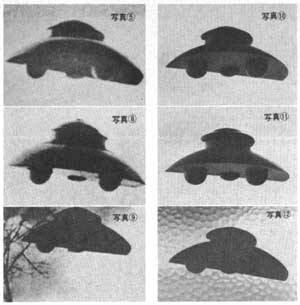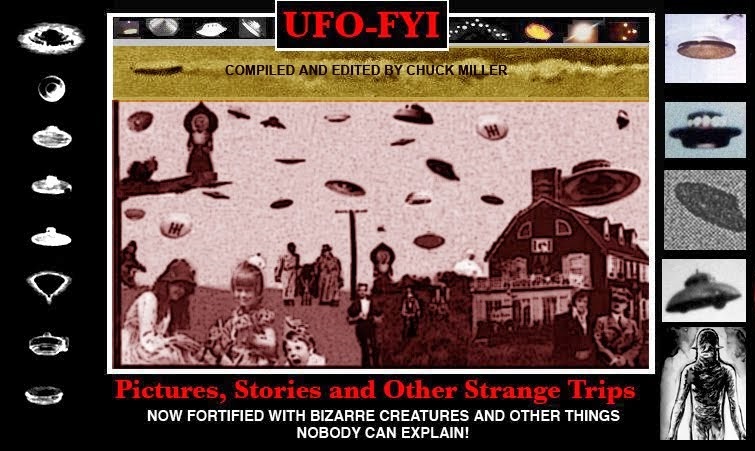
I have to admit I've always loved the contactees and their wild tales. They represent a state of being where objective reality is of little consequence, and that can be very appealing. I've never understood why some people spend so much time and so much money "debunking" these obvious phonies instead of just enjoying the show. If I wanted to, I could do a year-long study and provide you with reams of scientific proof that the events in "Alice in Wonderland" never really took place, that the White Rabbit was a weather balloon and the Mad Hatter was Venus. But at the end of the day, what would I really have accomplished?
I recently read George Adamski's opus, "Inside the Flying Saucers," and I found it charming in its goofy amiability. I find it difficult to begrudge him the success he enjoyed. As cults go, his was pretty harmless. He basically reworked the Sermon on the Mount for the dawn of the Space Age, presenting a gospel of love, caring and tolerance. There are worse things a person could do. Look at Heaven's Gate, for example. Wasting all those brand-new Nikes...
Adamski was no worse than, say, Billy Graham, and a damn sight better than Pat Robertson.
Eventually, of course, the fringe mainstream (strange notion, that) moved from the beautiful and benevolent space brothers and sisters into the realm of bizarre, inhuman kidnappers and cattle-mutilators, and their unfathomable genetic agenda. I suspect that this shift reflects our struggle, as a race, to come to grips with the strange realities and possibilities of the post-atomic age.
 I am not an unbeliever, but I think the UFO phenomenon merits study on a number of different levels. In his book "Flying Saucers," C. G. Jung approaches it as a psychosocial phenomenon, and discusses its variety of implications. While he limits himself to this aspect of the thing, he does NOT suggest that UFO sightings are the product of individual pathology, nor does he cast any doubt on the objective reality of the phenomenon. But that kind of science wasn't his field, so he concentrated on the elements that were.
I am not an unbeliever, but I think the UFO phenomenon merits study on a number of different levels. In his book "Flying Saucers," C. G. Jung approaches it as a psychosocial phenomenon, and discusses its variety of implications. While he limits himself to this aspect of the thing, he does NOT suggest that UFO sightings are the product of individual pathology, nor does he cast any doubt on the objective reality of the phenomenon. But that kind of science wasn't his field, so he concentrated on the elements that were.The objective reality of the UFO is a fascinating study. No less fascinating is the way that we, as individuals and as a culture, approach and interpret what we are seeing. We really don't know exactly what these things are, and our imaginations, expectations and hopes fill in the inevitable blank spots. Thus, the contactees and their followers are no less important sociologically than the rigid, scientific skeptics. Not only do we not understand the UFO phenomenon, we do not even fully understand ourselves. And uch understanding may be a necessary step on the road to true, meaningful, beneficial contact with the unfathomable intelligences behind the UFO.
 At our current stage of development as a species, efforts to explain and duplicate exotic propulsion systems may be totally futile. No responsible alien race would give a civilization like ours such powerful and potentially lethal technologies. What human adult would attempt to exchange information and explain his or her intentions to a four-month-old infant? There would be no point until the child becomes much older. Likewise, no thinking adult would give a baby a vial of deadly poison or a taser. And the child cannot grow simply by duplicating the behavior of adults. First he must gain understanding, in his own way and at his own pace. Are there any human beings on this earth who were never impatient to participate in the adult world, and anxious and frustrated when they could not? The only answer is to be patient and grow. That is how one reaches adulthood, gradually, not in a single leap.
At our current stage of development as a species, efforts to explain and duplicate exotic propulsion systems may be totally futile. No responsible alien race would give a civilization like ours such powerful and potentially lethal technologies. What human adult would attempt to exchange information and explain his or her intentions to a four-month-old infant? There would be no point until the child becomes much older. Likewise, no thinking adult would give a baby a vial of deadly poison or a taser. And the child cannot grow simply by duplicating the behavior of adults. First he must gain understanding, in his own way and at his own pace. Are there any human beings on this earth who were never impatient to participate in the adult world, and anxious and frustrated when they could not? The only answer is to be patient and grow. That is how one reaches adulthood, gradually, not in a single leap. We could all benefit from less rigid thinking on both sides of the debate, less absolute insistence that this or that theory is the complete answer to the riddle. The more time people like Stanton Friedman and the late Phillip Klass spend sniping at one another and endlessly studying and debating issues like typewriters and Harry S. Truman's autograph, the less we truly learn. Whatever the objective reality behind it, the phenomenon can teach us a great deal about ourselves and our society, if we are willing to listen without prejudice to even the most outlandish points of view.
We could all benefit from less rigid thinking on both sides of the debate, less absolute insistence that this or that theory is the complete answer to the riddle. The more time people like Stanton Friedman and the late Phillip Klass spend sniping at one another and endlessly studying and debating issues like typewriters and Harry S. Truman's autograph, the less we truly learn. Whatever the objective reality behind it, the phenomenon can teach us a great deal about ourselves and our society, if we are willing to listen without prejudice to even the most outlandish points of view.
Writer Dave Cosnette says, "On 26th February 1965, while Adamski was staying at Silver Spring, Colorado, he and a friend, Madeleine Rodeffer, witnessed another scout ship. (ABOVE) Fortunately, Adamski's 'space brothers' had told him to have a cine camera ready and he caught the craft on film. William T. Sherwood, an optical physicist and former project development leader for Eastman-Kodak, spent a great deal of time analyzing this footage. His conclusions were that there were no signs of duplicity, and determined that the object was approximately 8 metres across. Analysts are still at a loss to explain how or why the craft distorts from frame to frame. Veteran aeronautics engineer Leonard Cramp suggests this was caused by a powerful gravitational field produced by the craft. Unfortunately every copy of the film has been stolen, so we may never know the answer."
(© Dave Cosnette 2001) SEE ORIGINAL ARTICLE
On the other hand, FORGETO MORI says:
"The movie is often attributed to Madeleine Rodeffer, but even sources related to Adamski admit that the well known contactee is the culprit. Mrs Rodeffer herself admitted that. This detail is important because, as we can see, the footage shows the classic scout ship photographed (and drawn) over ten years before. That’s not a surprise since the cameraman was the same."But the ship is slightly different, and watching the movie, we can realize that its shape does indeed change, contrary to the first impression that it may have been just a flat paper cut-out hanging in front of the camera. So, how did Adamski create this footage?
Japanese researcher Junichi Takanashi successfully reproduced the Adamski-Rodeffer footage. The model used by Adamski was three-dimensional, and didn’t hang like something suspended by a wire. And even though his scout ship had three outer spheres around a central one, in his footage we can only see two outer spheres around the central one.



No comments:
Post a Comment
Note: Only a member of this blog may post a comment.